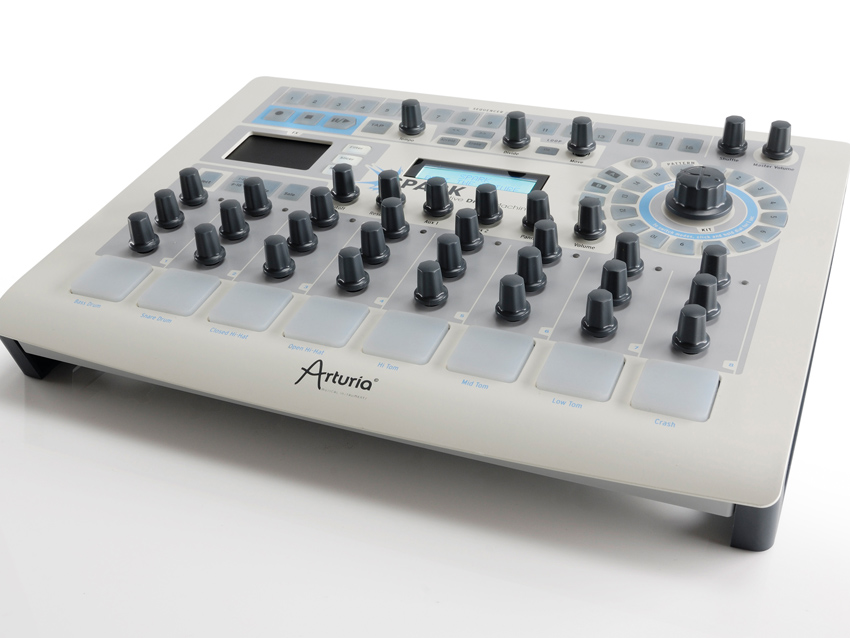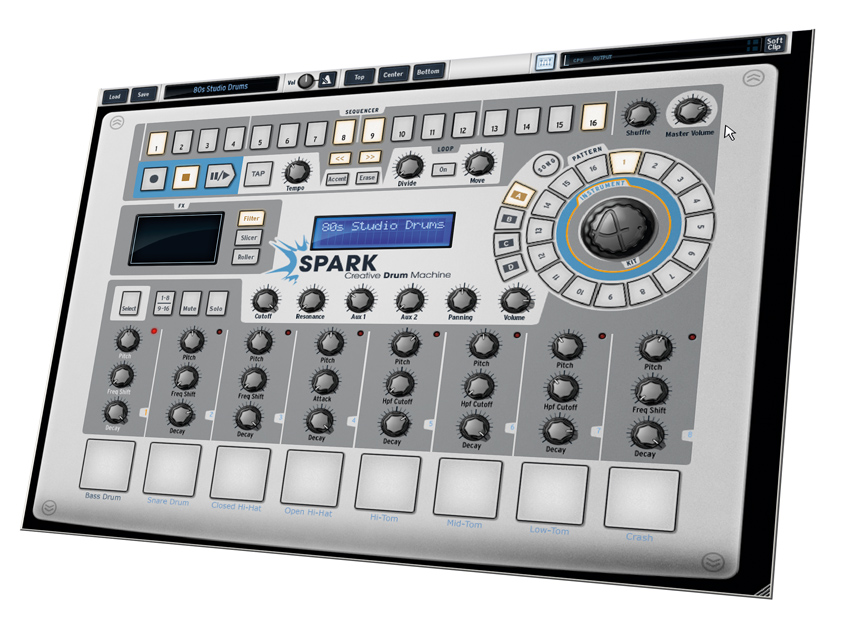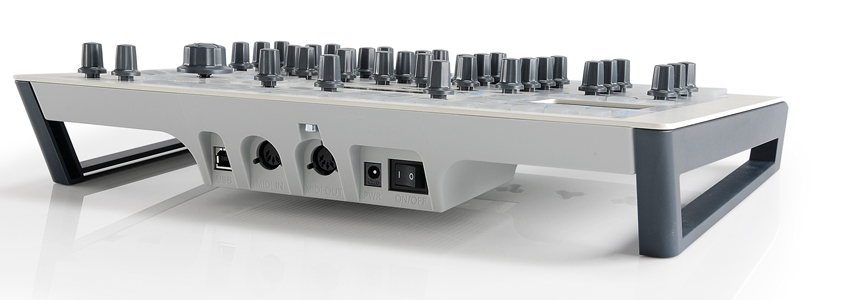MusicRadar Verdict
A great beat-making system and future updates should help the sound editing experience.
Pros
- +
Instant parameter access. Ease of beat programming. Wide ranging sound creation options.
Cons
- -
Horizontal pad layout. Small screen. Manual could be clearer.
MusicRadar's got your back

Arturia Spark

Arturia Spark

Arturia Spark

Arturia Spark
Arturia has been at the forefront of the software-based instrument and synthesizer emulation scene for over ten years. While, more recently the company has ventured into the realms of hardware with their Origin Keyboard and Desktop boxes.
The latest instalment is the Spark 'Creative Drum Machine', a combination of hardware and software.
"We had fun with Spark and it got us making beats in new and interesting ways."
Electric dreams
On opening the box, you will find the hardware controller (with USB cable), DVD, registration card and printed manual, with the installation process being no more complicated than any other USB audio device.
The front-end software comes in two main flavours - standalone and plug-in. We opted initially to test Spark in standalone mode. A graphical representation of the controller interface popped-up on screen as well as a message saying that it was connecting to the hardware (though this only took a few seconds).
The first time we booted the system, a window informed us that a firmware update was available for the controller and guided me through the process. After restart we were ready to go. So far, so simple.
Given that the point of hardware controllers is to free you from the perceived shackles of screen and mouse editing, we decided to dive headlong into some beat-making using just the unit that was sitting in front of us.
Using the great-sounding '80's Studio Drums' kit we bashed and tweaked our way through real-time recording, step-time programming, kit, drum and pattern selection, as well as a healthy dose of individual drum parameter editing.
Want all the hottest music and gear news, reviews, deals, features and more, direct to your inbox? Sign up here.
Everything fell into place quite easily without ever looking at the host computer screen, although when it came to engaging the metronome or arranging patterns in song mode (which didn't appear to work as detailed in the manual) things got a little trickier.
There are also a number of areas of functionality that are not covered by the hardware controller, and we'll take a look at these later.
Light my fire
As far as the hardware goes what you have is pleasant-looking metal-fronted unit populated with drum pads at the bottom. The pads have a springiness to them, not unlike an Akai MPC, and are a broadly similar size.
The horizontal layout is not perhaps as flexible as the MPC or Native Instruments Maschine's grid-style, and with only eight pads you need to move between the two pad-banks quite often when working on grooves.
The three unlabelled infinite encoder controls above each pad can be assigned to various sound-editing parameters, but you will need to look at your computer screen to see what each knob controls.
Again, we can't help but feel the competition do this better, even if some flexibility is compromised at the expense of clarity. None of this is helped by the slow refresh rate of the backlit - text only - LCD screen.
The middle section however, consisting of six hardwired editing controls (for volume, pan filtering and Aux FX levels), is better thought out, and therefore more immediately usable.

To the left of this sits a touch-sensitive FX pad and to the right, the pattern/song buttons and kit/instrument selection and load dial. At the top of the unit the 16 beat selection/programming buttons, transport and looping controls all do exactly what you want them to do, making programming and editing of individual pad patterns simple and effective.
This is 'old-skool' drum programming at its pared-down best, and is one area in which hardware control surfaces win over software, albeit for the simplest of reasons - it's just more fun.
As far as interconnectivity goes the Spark controller has a USB port (the only thing you need to use in standard host mode), as well as MIDI In/Out, a PSU input and power switch.
The USB provides all you need in terms of communication and power if you use Spark as closed system. If you use Spark as a plug-in within your host DAW, you can sync patterns and songs to the main project tempo, or use the pads to programme direct to a MIDI track.
Interestingly, the MIDI interface facilitates the use of the Spark unit as a generic MIDI controller, making it capable of transmitting customisable MIDI messages from most of its front panel controls.
This mode is engaged by pressing a number of buttons simultaneously, with MIDI mapping and management handled by the included (but separate) MIDI Controller software. However, if you use Spark in this way, it ceases to provide direct control over the plug-in (or standalone) sound engine, so is more of a bonus than a must-buy feature.
The software itself is presented as a vertically scalable window. Sliding the interface position control or pressing one of the navigation buttons takes you to additional screens that allow for more detailed editing and control. The top portion is devoted to Pattern and Song programming and provides a greater level of interactivity, visibility and editing power than is possible with the hardware alone.
Multiple instruments may be programmed on a grid simultaneously and additional views provide for more detailed automation editing, this is logical and clear, and integrates well with the controller's functions.
The bottom of the window hosts the 'Studio' - where kit and instrument editing takes places - the 'Mixer' and 'Library' sections. The Library panel allows you to manage the pattern and kit settings for the whole project.
You can even import MIDI or REX files and export patterns as MIDI or audio files (even direct to your DAW). This section also allows you to move kits, instruments, banks and patterns between projects, create new custom projects from scratch or import or export user generated .SPK files (that facilitate the sharing of content).
The mixer panel consists of a 16-channel mixer (representing each pad's instrument), with each channel containing output routing (to one of the 16 separate outputs), pan, auxiliary send and insert FX controls. There are two insert FX slots available per channel, each with a choice of seven effects, including bitcrushing, distortion, chorus, phasing, compression, EQ and delay.
The two Aux FX allow for the addition of Reverb or Delay on a global basis, whilst the main outs have their own insert FX slots for extra processing.
Grandmaster flash
Spark is fun to use, integrating well into the DAW environment when run as a plug-in, and is capable of some great results.
The pads feel much more satisfying to play than a MIDI keyboard when it comes to programming beats, and the profusion of 'real' editing controls certainly benefit this philosophy.
While the body of hardware unit solidly built, the struts connecting pairs of legs underneath feel flimsy, despite looking like they want to double as carrying handles.
The size of the screen also predicates the use of the computer software to enable detailed editing of the underlying instruments, although with any product of this type there is always a tension between functional visibility and creative simplicity.
The profusion of sound generation models, each with varying subsets of tweakable parameters, makes for a complicated landscape when building your own kit. Individual instruments and sound engine parameters are not discussed in the manual, and this unfortunately hides away much of Spark's potential.
There a few other functional issues that we have been told will be addressed in future updates (such as drum mute/choke groups), but in most other respects the systems feels coherent.
Taken as a whole, Spark is in many ways a great system. It places limitations on the user in a similar manner to many old (and classic) drum machines, and this appears to be Arturia's intention. For many, hiding some of the fiddly stuff away is a good thing and helps you focus your creative spirit.
The sounds are strong, particularly if Electronica is your thing, though clearly this is not meant as competition for a multi-gigabyte sample library. Overall, we had fun with Spark and it got us making beats in new and interesting ways.
Future Music is the number one magazine for today's producers. Packed with technique and technology we'll help you make great new music. All-access artist interviews, in-depth gear reviews, essential production tutorials and much more. Every marvellous monthly edition features reliable reviews of the latest and greatest hardware and software technology and techniques, unparalleled advice, in-depth interviews, sensational free samples and so much more to improve the experience and outcome of your music-making.
